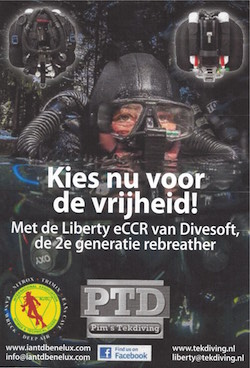Megalodon Apeks 2.7
Closed Circuit eCCR //
1 August
READ THIS FIRST!
| Name: | Megalodon Apeks 2.7 |
| Manufacturer: | Innerspace Systems Corporation (ISC) |
| Website: | http://www.customrebreathers.com/ |
| Since: | 1999 |
| Type: | eCCR |
| CE: | Yes, since 2011 |
| Lungs: | Over the shoulder |
| Weight: | 25 - 29 kg (ready to dive) |
| Scrubber duration: | 3 hours |
| Weight Scrubber: | 2.5 kg |
| ADV (Automatic Diluent Valve): | Yes |
| HUD (Head Up Display): | Yes |
| BOV (Bail Out Valve): | Optional |
| (Deco-) computer: | Optional (Shearwater) |
| Tanks: | 3 ltr |
| My deepest dive with the unit: | 160 mtr |
| Price: | 12.000 EUR (ex shipping, incl. taxes) Depending on exchange rate USD/EUR |
| General: 2 stars: has been downgraded because of stop of production and stop of support from 2017. New version Meg15 is hard to get. Long delivery times and no CE certification. | The Megalodon is the best CCR I dived sofar. It is my preferred CCR. For many purposes and different dives. Rounded up it got 5 stars, for several reasons: robustness, easy of use, ease of travel, modularity, trim/buoyancy. But now I downgraded the Meg because of the high USD. Other CCR’s have copied the concept of the Meg, which shows its perfect design. The only drawback is its price… Quite expensive. But is worth the “pain”. I used the Meg in several environments (cave, wreck, sea, sweet water) and it always performed without any problems. Maintenance is easy an setting up the unit is quickly done. I’m quite “tough” on my equipment and the Meg always resists my “bad” handling. For travelling the Meg is the best unit as well. Because of its modularity one can divide parts all over the suitcases. I always put the head with the electronics in my hand luggage. |
| 1. Ease of use (set-up, maintenance) 5 stars | It’s easy to calibrate the unit and to prepare it for diving. Also taking it apart can be done in several minutes. |
| 2. Buoyancy/trim 4 stars | Trim is good, but depends strongly of the placement of extra weight. |
| 3. WOB 4 stars | The position of the lungs makes it a unit, which is easy to breathe. The WOB of the Meg is good in every position. |
| 4. Travel (modularity) 5 stars | One can put on any size tanks. Any backplate. And even any BCD and any first stages. |
| 5. Safety 5 stars | Although its lack of very advanced technology, its robustness is legendary and an example for the CCR market. The Meg is practically indestructible. It has all the necessary safety features like a HUD, back up unit and ADV. A BOV (non-CE) is optional. |
| 6. Price 1 star | A lot of money is needed (in Europe). Transportation and import duties make it an expensive unit. Flying over to Seattle to pick up the unit personally (and skip customs) is sometimes cheaper. |
| 7. Service/after sales/availability parts 1 star | Bad after sales. Difficult to contact manufacturer. Long delivery times. |
| 8. Build quality 5 stars | Indestructible. |
| 9. Cave diving 5 stars | Only the necessary safety items are “on board”: no “over-engineering”. The Meg can be easily adapted to specific (cave) environments. |
| 10. Deep and X-treme diving 4 stars | The unit is CE rated until 100 mtr. The handsets to 140 mtr. People who dive the Meg deeper then 140 mtr put baby oil in the handsets. On my dive to 160 mtr I did not do that. |
